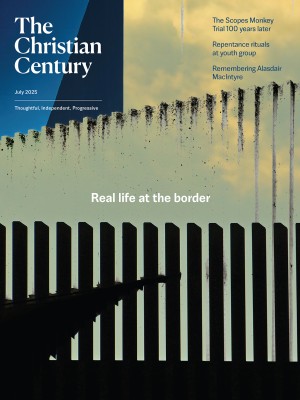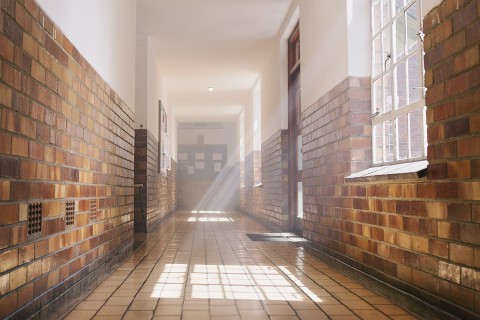
The title of a presidential order handed down on Inauguration Day announces a bold new initiative: “Protecting the American People Against Invasion.” In 23 sections with dozens of subsections, the directive revokes a raft of the Biden administration’s executive orders (on addressing the causes of migration, safe and orderly processing of asylum seekers, reunification of families, and more) and launches new enforcement measures. Thousands of active military troops are being dispatched to the Mexican border, supplementing the 16,500 Border Patrol officers and 2,200 National Guard members already deployed under Biden. The order fulfills one of President Trump’s most repeated campaign promises: that on day one of his presidency he would move swiftly to detain and deport 11 million undocumented residents of the United States.
Trump has never felt constrained by facts. The alleged invasion, effective as it was as a campaign tactic, was one of his most transparent and egregious falsehoods. Those of us who live in the borderlands see a very different reality. My home in Green Valley, Arizona, is just 40 miles from Nogales, Sonora, where I travel often to visit migrant shelters, see my dentist, and visit favorite taquerias. From this vantage point, we have seen a dramatic ebb and flow of migration.
Read our latest issue or browse back issues.
The massive influx in the first years of the 2020s, spanning the Trump and Biden presidencies, has given way to a sharp decline since 2023. Reported encounters between migrants and Border Patrol agents, leading either to release with a court date or to expulsion, reached 200,000 per month early in the Obama presidency, then dropped to a quarter of that number later in his term and early in his successor’s. They climbed back to 200,000 per month late in Trump’s first term, then higher still in the early Biden years. Since 2023, however, numbers have dropped even more sharply than in Obama’s term. By late 2024, the border was quieter and more orderly than at any time in the past two decades. That decline has continued, both before Trump’s inauguration and since.
What has caused these wide fluctuations? Stricter enforcement played a role. Obama, Trump, and Biden all tightened border security, and a divided Congress refused to offer any legal path to citizenship. Equally important in bringing order to the chaos on the border was the CBP One app made available to asylum seekers in 2023. By late 2024, more migrants were using the government app and following legal channels than were attempting to cross without permission. Mexican immigration officials, US Border Patrol agents, and humanitarian groups all welcomed the option of an orderly and legal process for asylum application.
If there was no invasion to repel, what changes have resulted from Trump’s directives? On Inauguration Day, the asylum app was shut down and all scheduled initial asylum hearings were canceled. A few days later, at a shelter in Nogales, Sonora, I met families fleeing from death threats in Venezuela and Guatemala who presented themselves at the port of entry, showing agents the appointment confirmation that had been sent to them through the app months earlier, only to be turned away.
The beds at that shelter are now nearly empty. At a nearby shelter that accommodates families for longer stays, the dormitories are half empty. Shelter residents have lost all hope for asylum application, and they have lost their faith in the US government to honor its promises. Most are now leaving the shelters to return to their home countries—despite the dangers from which they fled—or to make a new life in northern Mexico.
In recent years, I have volunteered at the Nogales port of entry with a group called the Green Valley-Sahuarita Samaritans, helping new arrivals who passed their initial asylum interview and received a court date for a formal hearing. (I write as one of many volunteers, not in any official capacity, and do not speak for the Samaritans.) I’ve met them as they are released from Border Patrol screening and helped them find their way to their sponsors, most often churches or family members, elsewhere in the United States. This work is no longer needed, because no one is permitted to enter the country to apply for asylum. The temporary shelters in Tucson and Phoenix, where asylum seekers used to stay for a night or two in transit, are closing their doors.
Those whom I met at the border are settled now in new communities across the United States, waiting for years for their asylum hearing. Justice Department reports show 379,450 new asylum applications in 2022 and 2023. Among the cases heard in immigration court, less than 15 percent were approved. The backlog for asylum hearings has now reached more than 2 million, and yet every recent administration, Republican or Democratic, has poured money into enforcement without addressing the critical need for timely adjudication.
Until January, temporary residency was granted to those who passed an initial screening at the border and submitted a legal asylum appeal. But now ICE agents are arresting and deporting immigrants and asylum seekers regardless of their legal status. I think of the young Cuban lawyer whom I assisted a year ago on his way to join family members in New York. “I could not practice law in Cuba,” he said, “after I criticized the government. So I opened a bakery. But the police raided my bakery and stole all my equipment. I have been waiting in Mexico for nine months until my appointment came up today, and now I have a place to live and work until my final court date.” Very likely he is now being targeted for immediate deportation.
The promised mass expulsion of millions of undocumented residents, however, has not materialized. In January 2025, there were 29,000 Border Patrol encounters, most leading quickly to expulsion. That adds up to one arrest per month per agent on patrol. In February, the number was lower still. Newscasts and social media frequently show dramatic raids leading to arrests, but these are dramas staged for the camera rather than coordinated enforcement measures. Workplace raids in Illinois, New Jersey, and Texas swept up US citizens, including veterans, along with others. In Phoenix, a small army of armed ICE agents surrounded a home, setting off stun grenades from an armored vehicle and issuing demands through bullhorns, until one individual, a 61-year-old man who entered the country without papers two decades ago, voluntarily submitted to arrest to spare his family and neighbors further harassment. Another criminal apprehended, crowed the conservative media, without noting that his crimes were minor misdemeanors from many years earlier.
All the same, the situation on the border has changed dramatically in recent months. For many years, volunteers from churches and human rights organizations have fanned out across the desert, distributing water and food. The migrants we encounter nearly always ask to be directed to Border Patrol stations, where they are processed and then transferred to temporary detention facilities. Most are quickly deported, but some are released with a future court date. The number of these travelers has declined nearly to zero. One Samaritan volunteer told me she had seen no one at all for two weeks at a once-busy crossing point.
Is an invasion still an invasion if there are no invaders? A tree falling in a forest may be heard by no one, but the nonexistent invading army is closely observed by tens of thousands of US agents.
While the border is quieter in some ways, it is far more unsettled in others. When Samaritans report on their searches in the desert at the group’s biweekly meetings, they often describe acts of vandalism. I’ve heard stories of water jugs slashed, of food caches ripped open and scattered. There have been occasional confrontations with militia members, self-appointed guardians of the border, but until recently, the abuse the volunteers endured was only verbal.
That may be changing now. Four Samaritan volunteers told us at a recent meeting that they’d been visiting a remote ranch near the border. The ranch’s owner, knowing migrants often pass nearby, welcomes the water station located on his land. Vandalism had been reported a few days earlier, so the volunteers went to see whether the jugs were intact. They were. But near them stood several men, who pointed automatic weapons in the volunteers’ direction and shouted at them to turn around.
The volunteers turned their SUV around to avoid any confrontation, but the armed men gave chase. As they passed a uniformed agent in his Border Patrol vehicle, the Samaritans called out to him: “What can we do about the vigilantes with guns who are chasing us?” “You’d better wait and let them talk to you,” he replied. “They are federal agents.”
The volunteers waited, they told us, until the men pulled up—none of them in uniform, none wearing any visible ID or agency badge, in a vehicle with no markings. Still pointing their guns, they ordered the group to step outside of their vehicle, demanded their passports, and put them in handcuffs. “You are violating federal law by helping illegals,” they shouted, “and driving on this road is illegal too.” (It is not.) After berating the volunteers for several minutes, the men returned the passports, but they confiscated a cell phone when one of the volunteers appeared to be filming them. At last they removed the handcuffs and released the Samaritans, warning them to be ready to answer criminal indictments. “On what charge?” they asked. Assaulting a federal agent, they were told.
Are these men really federal agents? Are they militia vigilantes? Or, more frightening still, are they both? Border watchers have told me that advisers to the president are recruiting and equipping “special agents” to patrol the border for both migrants and migrant sympathizers, all under no visible authority but their own. I have found no evidence to support these rumors. What we do know is that on April 11, the Trump administration—again citing the nonexistent crisis at the border—declared the entire southern border a closed military zone, authorizing active-duty military to arrest anyone they encounter, whether travelers from the south or volunteers from the north, and place them in military detention.
In recent years, relations between Samaritans and Border Patrol have been respectful and cooperative most of the time. When I toured the Border Patrol station near Nogales a few months ago, the agents emphasized that in their enforcement of immigration laws, protecting the health and safety of migrants was a high priority. They added that they are grateful for the Samaritans’ efforts as well. But the agent to whom the recent volunteers turned for help evidently knew enough about the armed men and their tactics that he decided he should stand aside and watch the volunteers being treated as if they were the ones threatening to open fire with assault rifles.
It is evident that the purpose of the president’s fearmongering rhetoric about an invasion is not to remove undocumented US residents. Trump and his wealthy supporters have nothing to gain, and a great deal to lose, if mass deportation were to become a reality rather than an empty boast. Manufacturing, agriculture, and the entertainment industry would all collapse if a large portion of their workforce were expelled. The lower the prestige and pay of an employment category in the American economy, the higher the proportion of openings filled by undocumented workers.
Trump and his allies in Congress know that their characterization of undocumented residents as criminals preying on citizens has no basis in fact. US citizens are twice as likely to commit crimes as undocumented residents, and four times as likely to commit violent crimes. How many of those now being detained and deported have criminal records is difficult to determine. Reporters estimate about half, based on interviews with federal agents and family members left behind, but agency reports are infrequent and inconsistent. One figure can be verified from court filings: of the government’s deportation requests to immigration court in January and February of 2025, only 1 percent cite criminal acts other than illegal entry.
The sporadic enforcement actions undertaken so far have already gone a long way to achieve their unstated goal: to preserve an enormous pool of workers who will accept low wages, unsafe conditions, and job insecurity without complaint, knowing that appealing to a supervisor for fair treatment may trigger dismissal and deportation. Whether we acknowledge it or not, the American dream is built on the nightmares that workers in our fields, factories, and restaurants endure every day. The true purpose of Trump’s crackdown on undocumented immigrants is not to send workers away, cutting into the profits of business owners, but to keep them just where they are: underpaid, overworked, unrepresented by unions, and living in constant fear of immigration authorities and self-appointed vigilantes.
Here in the borderlands, “Make America Great Again” could more honestly be expressed as “Make Everyone Afraid Again.” On the US side of the border, volunteers who seek to help refugees from violence at home are now afraid that our efforts will lead to confrontation with unidentified armed men who may or may not be deputized by our government. On the Mexican side, those who still seek to cross are afraid of the relentless demands and violent actions of the drug cartels, who are perhaps the greatest beneficiaries of hardened US border policies since they can now demand tens of thousands of dollars to facilitate a crossing. Pastors and community workers are afraid to protest inhumane policies for fear of social media attacks and funding cutoffs. Politicians are afraid to stand up for their constituents and for the Constitution, lest they become targets of slander and libel.
“Perfect love casts out fear,” advises scripture (1 John 4:18). My pastor, Alison Harrington, reminds us often that living under a repressive monarch who seeks to intimidate and manipulate has been a familiar experience for followers of Jesus throughout the history of the church. But neither an autocratic emperor in Rome nor a narcissistic bully in Washington can extinguish the Spirit’s flame in our souls or empty our hearts of hope. Finding ourselves in the untracked borderland between the rule of law and the chaos of undeserved and unrestrained power, we can still help each other walk in the light.






